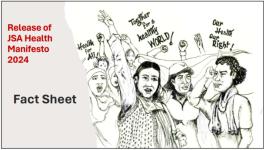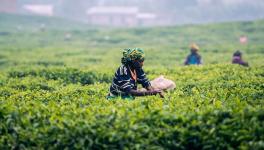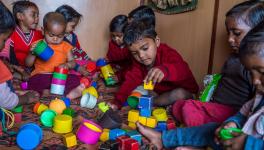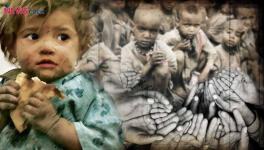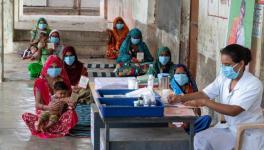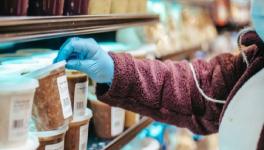How Not To Tackle Acute Malnutrition
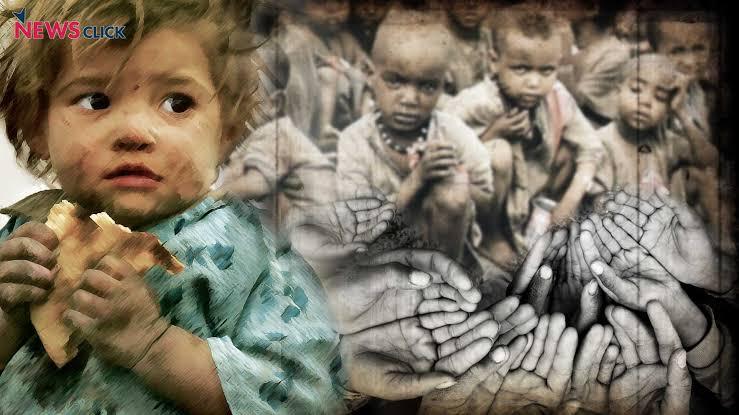
These statistics bear repeating: half of India’s underweight children are stunted, and of them, eight million suffer from severe and acute malnutrition, known to experts as SAM, its most extreme and visible form. Treating these children needs a cohesive and fast track program which, frankly, ought to have been the number one priority of the Modi government. Instead, needless controversies and delay plague India’s efforts to tackle undernourishment. It is all happening at the cost of children.
Data collected by nutritionists and doctors such as Vandana Prasad and Arun Gupta, who form the Working Group for Children Under Six, a joint effort of the Jan Swasthya Swastha and the Right to Food Campaign, have been advocating decentralised and community-based strategies to combat malnutrition. Based on their rigorous data, they have proposed tackling the problem of nutrition with nothing less than healthy and fresh home-cooked meals.
Instead of heeding their, or other expert’s advise, state governments readily clear the controversial Ready to Use Therapeutic Food (RUTF). This is what Maharashtra’s former chief minister Devendra Fadnavis had done: his administration had approved for SAM-afflicted children of his state the provision of a mixture of dehydrated milk, vegetable oil, sugar, peanut butter and vitamins. The plan, which had to be shelved, had selected this assortment of nutrients in an assembled form, as a lipid-rich paste which does not need to be cooked or mixed with water, over the much better choice of meals freshly prepared at home.
Both the World Health Organisation and the United Nation’s Children Fund and a big global food industry lobby have been promoting therapeutic foods as a short-term, emergency home-based treatment for SAM in India and elsewhere.
RUTF may have proved efficacious among children in disaster and famine situations, as was noted in Democratic Republic of the Congo, Mozambique and Ethiopia, where children were given this fortified peanut-paste. But, in the Indian context, experts have been saying that RUTF simply does not make sense. SAM children, they say, will be much better served if provided home-cooked food, and nothing less than that. One more factor against serving RUTF is that the mortality rate due to SAM in India is disputed. While the WHO, based on earlier studies done in Africa, finds the rate is at roughly 10%, a study done in tribal areas of Jharkhand and Odisha has found the rate at 1.2%. Therefore, the very idea that a “magic food” is needed to cure SAM has not been accepted by Indian public health experts.
“There is no scientific evidence to show that therapeutic foods are more successful in treating SAM than home-based hot cooked food,” says Purnima Upadhyay, coordinator of the Jan Aarogya Abhiyan, which works in the public health field in Maharashtra.
The RUTF scheme was pushed through in Maharashtra by none other than Pankaja Munde, the former minister of state for the department of women and child development. Munde reportedly cleared tenders worth more than Rs.6,000 crore for schemes targeting women and children, and allegedly dubious contractors, some blacklisted by the previous regime, had bagged them. Munde had also cleared tenders worth over Rs.200 crore in just one day for supplying chikki [a peanut-jaggery mix] to children in Anganwadi centres. The chikki turned out to be sub-standard. She had also sanctioned Rs.38 crore for RUTF, under the ‘energy dense nutritious food’ or EDNF banner, which was to feed 85,000 severely malnourished children registered under the government’s Integrated Child Development Services scheme. RUTF was introduced on a priority basis in rural of Maharashtra largely in its tribal belts reaching out to over 80,000 children.
Abhay Shukla, a medical doctor and public health expert, who is also a joint convener of the Jan Swasthya Abhiyan, says that three packets of RUTF sachets are to be given to a SAM-afflicted child under the age of six every day. The cost of this comes to Rs.80 per day. “But a child can be fed five nutritious home-cooked meals for only Rs.60 per day,” he says. These meals can include upma, poha, halwa, dry snacks, fortified kichri—and eggs.
Nonetheless, over the past three years, at least six Indian states including Madhya Pradesh, Jharkhand, Odisha and Bihar have conducted UNICEF-supported pilot studies to use RUTF. But their roll-out has been beset with problems. One of the selected regions, in the tribal belt of Nandurbar in Maharashtra, children were fed EDNF but a Jan Aarogya Abhiyan survey did not find the results very encouraging. Half the children remained malnourished despite having eaten the peanut paste for the mandatory three months.
Many children in the state’s tribal areas complained of dysentery and vomiting after consuming the paste. In some cases, children became addicted to the paste and refused to eat other foods. In such cases, parents pleaded with Anganwadi workers for the peanut paste—though they could scarcely afford it. In several cases, even after the prescribed dosage was provided to the child, he or she relapsed into malnourishment afterwards.
Mukta Srivastava of the Jan Aarogya Abhiyan and Anna Adhikar Abhiyan says that their evaluation of tribal children suffering from SAM, in two blocks of Nandurbar and Amravati districts, over April and May and August 2019, was not encouraging. “We found that there was no improvement in the nutritional status of 21 out of the 40 SAM children despite being on EDNF for three months. There was some improvement among 11 children, but the overall nutritional status improved for only seven children. So EDNF did not work for a majority of cases,” says Srivastava.
Upadhyay also says that in her work among the tribal children at Melghat in the Amravati district has made her extremely critical of these densely fortified foods. These foods, she says, “go against the basic tenets of child psychology”. Her argument is that adults would not want to eat the exact same food for all their meals in a single day. “Then how can we expect a sick child to eat this peanut paste non-stop for three months at a stretch,” she says.
A concern raised by food activists and nutritionists is that women have traditionally cooked for their families but the government seems to repose greater faith in contractors to provide food to children. “Rather than empowering local women as caretakers, they believe contractors can do the job better,” as Upadhyay says.
The parameters being laid down to tackle SAM are also contested. For instance, Melghat has some 10,000 children suffering from malnourishment, but the state government has identified 224 SAM children and the focus is on treating them, ignoring all others.
There is also a concern that figures of the government are unreliable and the scheme is shrouded in darkness. “This is a deeply flawed method of tackling malnutrition; it does not seem to be helping anybody, yet the government pushed it through,” says Shukla.
Ashish Satav, a medical doctor, runs MAHAN, a thirty-bed specialty hospital for the Konku tribal community in the forest region of Melghat. He has been dealing with severely malnourished children for two decades. Satav and his team of doctors have developed a therapeutic food that is mineral and vitamin-rich, and which tribal women can prepare from locally-available food sources.
“We have helped 77.7% children overcome SAM by using these local foods in 32 tribal villages,” says Satav. The success rate of RUTF is lower. “The local foods are also less expensive and more liked by children,” Satav says.
In 2017, with these factors in mind, the Union Ministry of Women and Child Development had written to state governments reminding them that the use of therapeutic foods to tackle malnutrition was “not an accepted policy” of the Indian government. The letter had also stated RUTF would “replace nutritional best practices and family foods that children would normally be eating”, though the decision of supplying it to children or not was left to state governments. It could negatively impact continued breastfeeding of infants and undermine “sustainable solutions for improving food availability and dietary diversity”.
Other organisations, including the Indian Academy of Pediatrics and the National Technical Board on Nutrition, also did not give their approval for the use of RUTF. “Management of SAM should not be a stand-alone program. It should integrate with community management therapeutic programs and linkages with child treatment center, district hospitals and tertiary level centers offering inpatient management for SAM and include judicious use of ready-to-use-therapeutic Food (RUTF). All sections of healthcare providers need to be trained in the integrated management of SAM,” the Indian Academy of Pediatrics had said in 2013.
Despite the lack of clearances, Maharashtra went ahead with the scheme, after which an NGO filed a writ petition against the state government’s tender, which forced the Maharashtra government to put the scheme on hold on 13 September 2017.
It turns out that this was a temporary hiccup because the government is now planning to extend RUTF to urban Anganwadis. The children will be treated in urban childcare centres just as their counterparts were in rural pockets. Maharashtra has around 98,000 Anganwadis, and data shows that from the around 58 lakh children screened in Maharashtra, 80,000 were severely underweight.
Even the RSS affiliate Swadeshi Jagran Manch has written to the Ministry of Women and Child Development emphasising the need to find local solutions rather than using packaged ready-to-use food, but the Prime Minister’s Office (PMO) has overruled these concerns as also the directives given by the ministries of health and women and child development, arguing that RUTF must be left to the discretion of the individual state governments. This inability to listen to the voices of nutritionists and public health doctors is going to cost the country dear.
Rashme Sehgal is an independent journalist. The views are personal.
Get the latest reports & analysis with people's perspective on Protests, movements & deep analytical videos, discussions of the current affairs in your Telegram app. Subscribe to NewsClick's Telegram channel & get Real-Time updates on stories, as they get published on our website.










